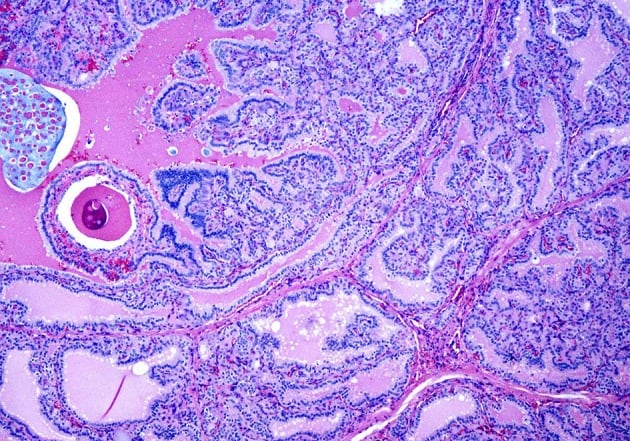Hyperthyroidism is the increased production and secretion of thyroid hormones. Thyrotoxicosis is the clinical syndrome that results from excess circulating thyroid hormones.
i) Diffuse toxic goitre or Grave’s disease or Basedow disease: It is caused by autoantibodies to TSH receptors. These antibodies stimulate the receptors on follicular cells to produce more thyroid hormone. It is more common in women. The thyroid is diffusely enlarged with increased vascularity. A bruit may be auscultated over the thyroid. Histology shows follicular and papillary hyperplasia with stromal infiltration with lymphocytes.

A case of Graves’ disease on medium power showing cells with round nuclei and even chromatin pattern lining the hyperplastic papillae.
ii) Toxic multinodular goitre: In this disorder, the thyroid shows multiple nodules with follicular and papillary hyperplasia with lymphocytic infiltration. It is seen in men and women, in older age groups. Atrial fibrillation is commonly associated.
iii) Follicular adenomas/toxic adenoma or Plummer’s disease: Also called hyperplastic nodules, they are benign tumors that secrete excess thyroid hormones, leading to suppression of rest of the thyroid. They are seen in women.
iv) Struma ovarii: It is associated with thyroid tissue in ovarian teratomas or dermoid cysts. Struma ovarii has > 50% thyroid tissue leading to hyperthyroidism.
Hyperthyroidism presents with tremors, tachycardia, weight loss in spite of increased appetite, heat intolerance and sweating. Other features include proximal myopathy, atrial fibrillation, heart failure, onycholysis (Plummer nails) and brisk tendon reflexes. Grave’s disease shows characteristic pretibial myxedema and exophthalmos.
Laboratory diagnosis is by thyroid hormonal assays for TSH, free T4 and total T3. TSH receptor antibodies are present in Grave’s disease.
| Thyroiditis, ectopic thyroid hormone secretion, exogenous thyroid hormone | Low TSH, elevated total, free T4 and total T3, low uptake on radioiodine scan |
| Grave’s disease | Low TSH, elevated free T4 and total T3, homogeneously high uptake on radioiodine scan |
| Toxic multinodular goitre | Low TSH, elevated free T4 and total T3, multiple areas of high uptake on radioiodine scan |
| Toxic adenoma | Low TSH, elevated free T4 and total T3, single area of high uptake with low uptake of rest of the thyroid gland on radioiodine scan |
| TSH secreting pituitary adenoma | Elevated TSH, elevated total and free T4 and total T3 |
| Subclinical hyperthyroidism | Low TSH, normal total T4 and total T3, normal free T4 |
Treatment for beta adrenergic symptoms such as tachycardia, palpitations, tremors etc is with beta blockers. Propranolol or atenolol can be used. Propranolol has the added advantage of blocking the peripheral conversion of T4 to T3 by inhibiting the enzyme 5’monodeiodinase.
Antithyroid medications are used for long term control and include methimazole, propylthiouracil (PTU) and radioactive iodine. Common side effects with methimazole and PTU are skin rashes, pruritus, arthralgia and gastrointestinal distress. Agranulocytosis is associated with both methimazole and propylthiouracil. WBC count and LFTs should be monitored at the beginning and during therapy. Both drugs can cause hepatitis, PPU more commonly also cause hepatic failure while methimazole may cause cholestasis. Methimazole is contraindicated in the first trimester of pregnancy, propylthiouracil is preferred. Methimazole causes aplasia cutis and birth defects in the first trimester. However, methimazole is used in second and third trimesters as PTU is associated with greater risk of hepatotoxicity. ANCA positive vasculitis may occur. Grave’s disease needs ablation with radioactive iodine. It is contraindicated in pregnancy and lactation due to radioactivity. Radioactive iodine therapy can also be used in toxic multinodular goitre and toxic adenoma. Thyroidectomy may be needed in resistant cases. There is a risk of injury to the recurrent laryngeal nerve, unilateral damage causing hoarseness and bilateral damage causing respiratory distress. There is also a risk of accidental parathyroidectomy. Patients undergoing thyroidectomy for hyperthyroidism have to be pretreated with antithyroid medications, potassium iodide and beta blockers to avoid thyroid storm. Potassium iodide reduces vascularity of the thyroid gland and decreases thyroid hormone release.
Sign up for free to take 3 quiz questions on this topic